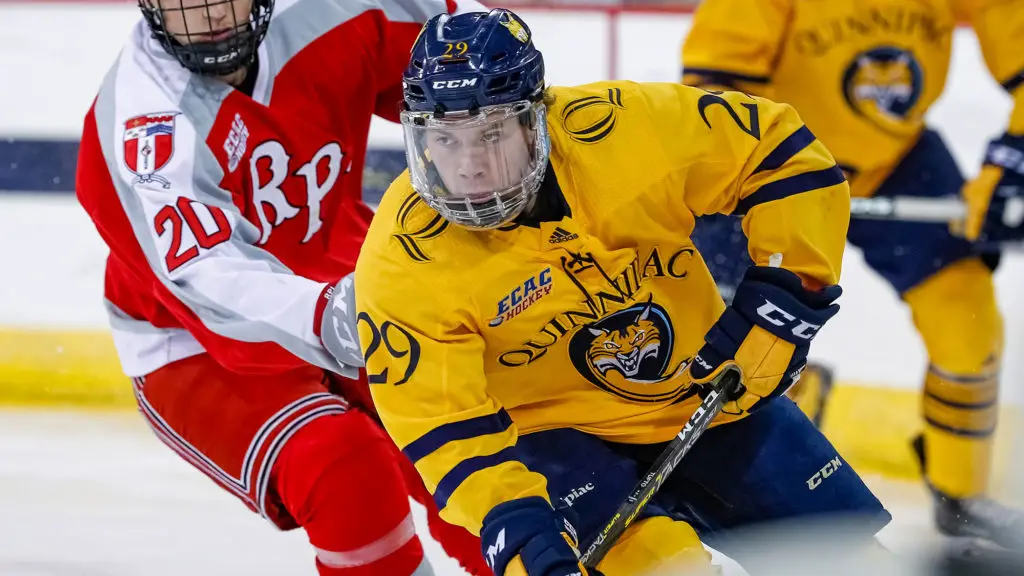
After the last game of the 2019-2020 ECAC Hockey season took two overtimes to decide, the start of this season took a little extra time to finalize as well.
Yale beat Union 2-1 in double overtime on March in the deciding game of the opening round of the league playoffs. That ended up being the final game of the ECAC Hockey season, as the COVID-19 pandemic led to widespread shutdowns across the country the following week.
In November, the Ivy League announced that it was cancelling winter sports, leaving the conference with only half of its 12 teams set to play. That number dwindled down to four several days later when Rensselaer and Union announced that they were cancelling their seasons, leaving the league scrambling to salvage some kind of a season.
“As a league staff, you recover and deal with the teams that are moving forward,” ECAC Hockey commissioner Steve Hagwell said.
On Dec. 9, ECAC Hockey announced an abbreviated league schedule for the four remaining teams: Clarkson, St. Lawrence, Colgate, and Quinnipiac. That final schedule capped off a process where “everything was on the table,” according to Hagwell.
Each team will play each other six times, for a total of 18 league games. The schedule is set so that multiple teams do not travel to the same site on a given day and includes open weekends in case of postponements.
Hagwell said the league is prepared to be flexible if anything changes in the coming weeks.
“I like our schedule,” Colgate coach Don Vaughan said. “It’s kind of like going back to the original six in the NHL where the teams played each other ten times. We’ll know each other very well before it’s all said and done. Everybody is trying. That’s the biggest message, trying to give these kids some kind of a season. I’m proud of everyone that has given us a go. I wake up and I’m like ‘Wow, I can’t believe that we’re going to be able to play some games with everything going on.’”
The four teams will participate in a single-elimination tournament on campus sites from March 18 -20, with the No. 1 seed hosting the No. 4 seed and the No. 2 seed hosting the No. 3 seed. After a day off, the league championship will be held on the campus of the highest remaining seed, with the winner advancing to the NCAA tournament.
The league has adopted safety protocols and standards that each team must adhere to. No fans will be allowed in any of the league’s rinks, but all the games are available on ESPN+.
“We are very fortunate that we had a plan that we put in place and it worked,” Vaughan said, adding that everyone from Colgate president Brian Casey and athletic director Nicki Moore up to the league’s administration have been instrumental in helping the season safely come together. “We know that there’s still a lot of uncertainty ahead. It’s very fluid, but at the end of the day we want to make sure that we are doing everything we can to keep our guys safe and prepared to play the best we can. We know things can change in a minute.”
This will also be the first year of a 3-on-3 overtime, as the NCAA approved that format for college hockey. Any ECAC conference game that is still tied after the five-minute overtime will end as a draw.
When the rest of the league eventually does return to play, many of those teams will have a drastically different look, as numerous players have either left early to sign professional contracts or transferred to other schools.
Harvard was hit especially hard by early departures, as forwards Jack Badini, Jack Drury, Henry Bowlby, and defensemen Reilly Walsh and Jack Rathbone all signed professional contracts.
Other early departures included Cornell forward Morgan Barron (New York Rangers), the reigning ECAC Hockey player of the year, and steady defensemen Alex Green (Tampa Bay) Also gone is Dartmouth’s Drew O’Connor, who signed with Pittsburgh after leading the league in goals last season and Yale defensemen Phil Kemp, who signed with Edmonton.
Union and RPI lost a pair of key players to transfer: Dutchmen senior Jack Adams transferred to Providence after missing last season with an injury, while Engineers goalie Owen Savory and his .929 career save percentage transferred to UMass Lowell.
But the biggest departure might be Dartmouth coach Bob Gaudet, who retired in April after 23 seasons at the head of the Big Green. Gaudet, who spent nine seasons as the head coach at Brown prior to coming to Dartmouth, had been the longest tenured coach in the league with 32 years of head coaching experience between the two schools. He’s replaced by former Quinnipiac defenseman and assistant coach Reid Cashman, who spent the last two seasons as an NHL assistant coach with the Washington Capitals.
“Bob’s a dear friend,” said Vaughan, who in his 28th season at Colgate is now the league’s longest tenured coach. “We talked during the season last year about different things and I just think with everything going on it was a moment for him to sort of step back and realize the legacy that he’s left and [be with] his family. We competed hard but at the end of the day, we were still friends. I think that’s a lesson to be learned for a lot of younger coaches. I’m going to miss him.”
Quinnipiac and St. Lawrence are set to begin the league’s abbreviated schedule at 4 p.m. on Dec. 31.
Here’s a look at the four teams that will be competing in ECAC Hockey this season. The teams are listed in the order of their predicted finish.
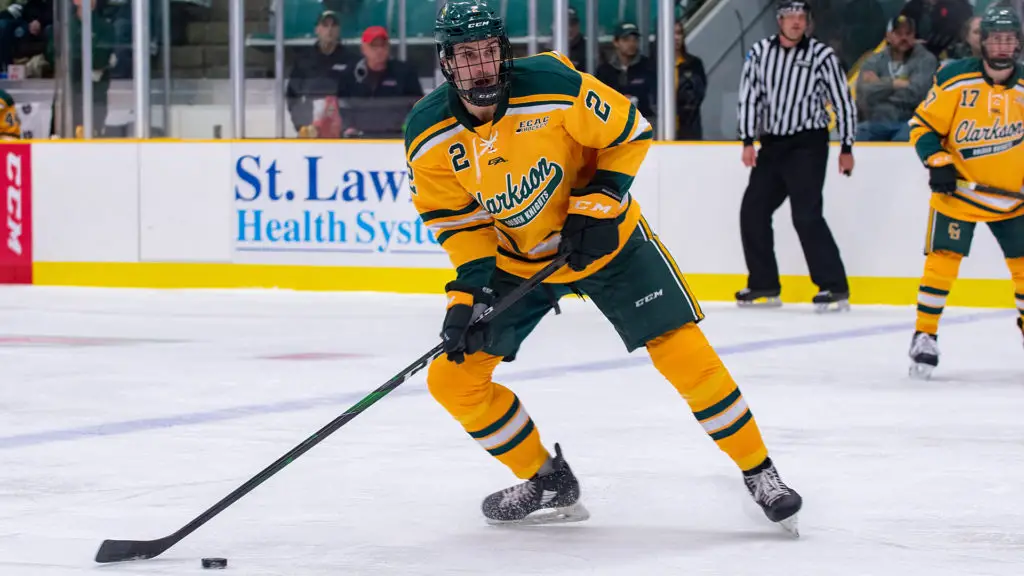
CLARKSON
Head coach: Casey Jones, entering his 10th year Clarkson
2019-20 overall record: 23-8-3 (16-5-1, second in ECAC Hockey)
Key returning players: Forwards Josh Dunne (13-14-27), Zach Tsekos (8-18-26), Jack Jacome (6-11-17), and F Anthony Romano (6-4-10), defenseman Connor McCarthy (9-11-20), and goalie Kris Oldham (appeared in one game in 2019-20, playing 34 minutes)
Key losses: Fowards Haralds Egles (14-18-32) and Devin Brosseau (8-21-29), defenseman Greg Moro (1-6-7), and goalie Frank Marotte (23-8-3, 1.78, .938)
Key additions: Forwards Alex Campbell (Omaha/USHL) and Nick Wicks (Alaska Anchorage), defenseman Noah Beck (Fargo/USHL), and goalie Ethan Haider (Sioux City/USHL)
2020-21 prediction: For the second time in as many seasons, Clarkson will need to replace its starting goaltender. Marotte, a graduate transfer, was the league’s goalie of the year last season. Oldham, another graduate transfer, looks to be the favorite for the top spot after seeing the majority of time in goal to start the season. He’s joined by incoming freshman Haider, who was drafted by Nashville in the fifth round of the 2019 NHL entry draft. Regardless of who is in goal, Clarkson should skate a strong lineup in front of them. Dunne was named the top defensive forward in the league last season and plays of lot of important minutes in virtually any situation. The Knights graduated three defensemen, but should still have plenty of depth throughout the lineup. That depth will be bolstered by newcomers and NHL draft picks Campbell and Beck. The short season could set things up for an unusual year, but Clarkson looks like a good bet to finish in first when it’s all said and done.
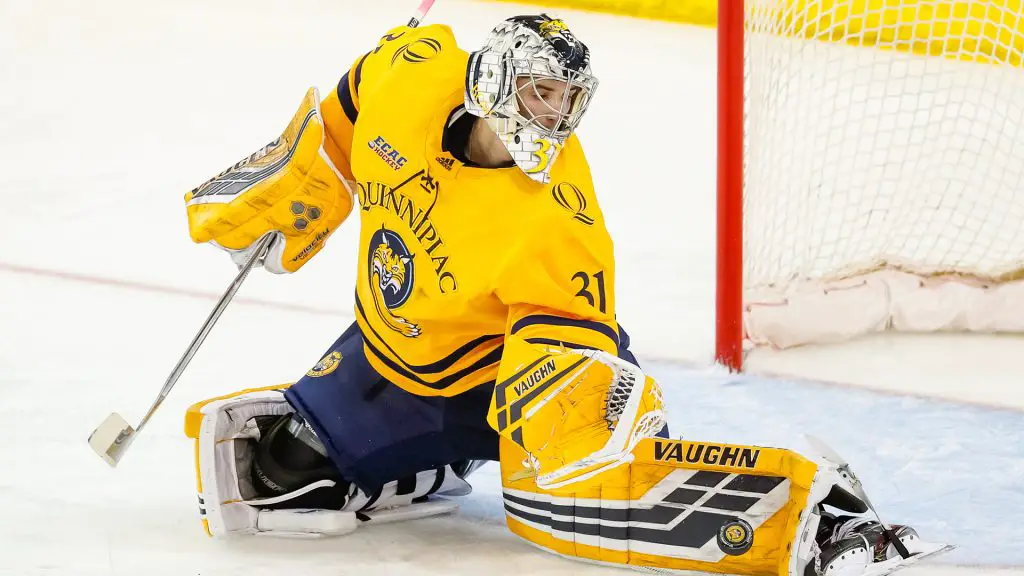
QUINNIPIAC
Head coach: Rand Pecknold, entering his 27th season at Quinnipiac.
2019-20 overall record: 21-11-2 (14-6-2, third in ECAC Hockey)
Key returning players: Forwards Odeen Tufto (7-31-38), Wyatt Bongiovanni (15-10-25), and Ethan de Jong (7-11-18), defensemen Peter DiLiberatore (6-15-21) and Zach Metsa (5-12-17), and goalie Keith Petruzzelli (21-10-2, 2.01, .920)
Key losses: Forwards Alex Whelan (13-11-24) and Nick Jermain (12-9-21), and defenseman Kārlis Čukste (4-14-18)
Key additions: Fowards Ty Smilanic (U.S. NTDP), Corey Clifton (Austin/NAHL), and Joey Cipollone (Vermont), and defensemen Iivari Räsänen (Muskegon/USHL) and Nick Bochen (Prince George/BCHL)
2020-21 prediction: After a slow start, the Bobcats ended last year a tear prior to COVID-19 prematurely ending the season. Much of that was due to the emergence of Petruzzelli in net, as the Detroit draft pick helped cover for a young Quinnipiac team on more than one occasion last year. But Quinnipiac’s underclassmen should be better with another year of experience, while the Bobcats continued their tradition of adding transfer students with the addition of Cipollone, who played two seasons at Vermont. Among the newcomers is a familiar name in Clifton. He’s the younger brother of Connor and Tim Clifton, who were crucial players on the 2016 team that made it to the national title game. Petruzzelli should be strong in goal once again, but whether or not Quinnipiac pushes Clarkson for first place will likely depend on the progress of the Bobcats’ returning underclassmen.
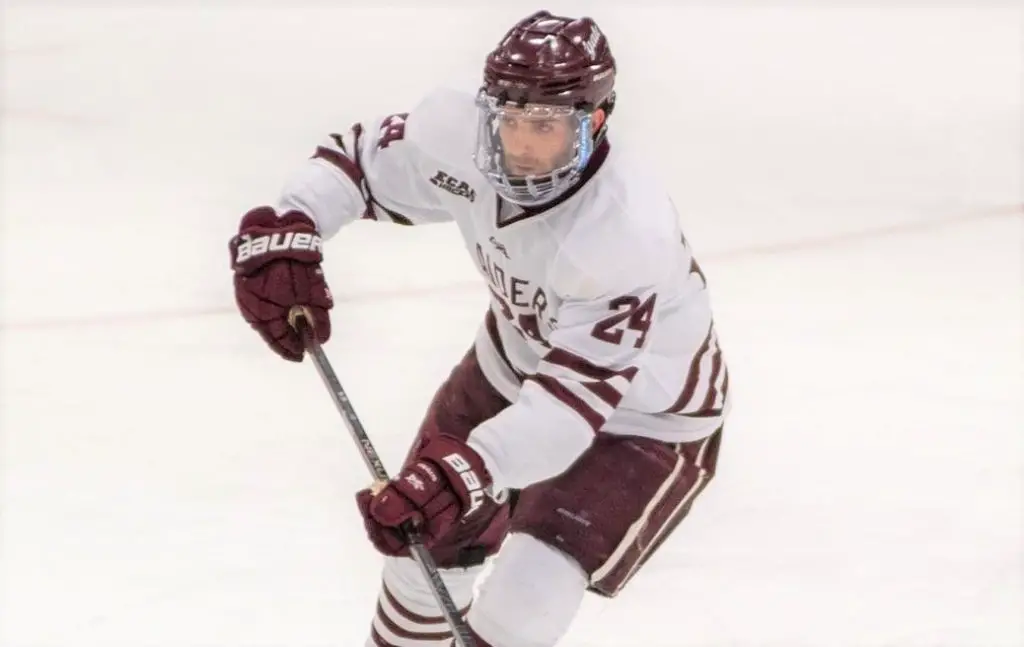
COLGATE
Head coach: Don Vaughan, entering his 28th year at Colgate.
2019-20 overall record: 12-16-8 (8-9-5, eighth in ECAC Hockey)
Key returning players: Forwards Colton Young (7-11-18) and Paul McAvoy (9-8-17), defenseman Nick Austin (0-10-10), and goalies Andrew Farrier (7-9-2, 2.34, .919) and Mitch Benson (5-7-6, 2.08, .925).
Key losses: Forwards Bobby McMann (10-10-20), Ben Sharf (10-10-20), and Jared Cockrell (7-10-17), and defenseman Paul Meyer (1-5-6, has appeared in every game over the last three seasons)
Key additions: Forwards Alex Young (Canmore/AJHL) and Ross Mitton (Omaha/USHL), defenseman Elliott McDermott (Carleton Place/CCHL), and goalie Carter Gylander (Sherwood Park/AJHL)
2020-21 prediction: The Raiders have good depth in goal and a solid defensive unit, led by Austin and senior Trevor Cosgrove. Offense will once again be a question mark for Colgate; the Raiders only have three players on their roster with more than ten career goals. Incoming freshman Alex Young, a San Jose draft pick, scored a goal in his first collegiate game last month against Clarkson. He’ll pair with older brother Colton, the Raiders’ top returning scorer, to give Colgate a pair of top-line threats. Colgate should be in most games thanks to its goaltending and defense, but it might be hard to match the offensive output of Clarkson and Quinnipiac.
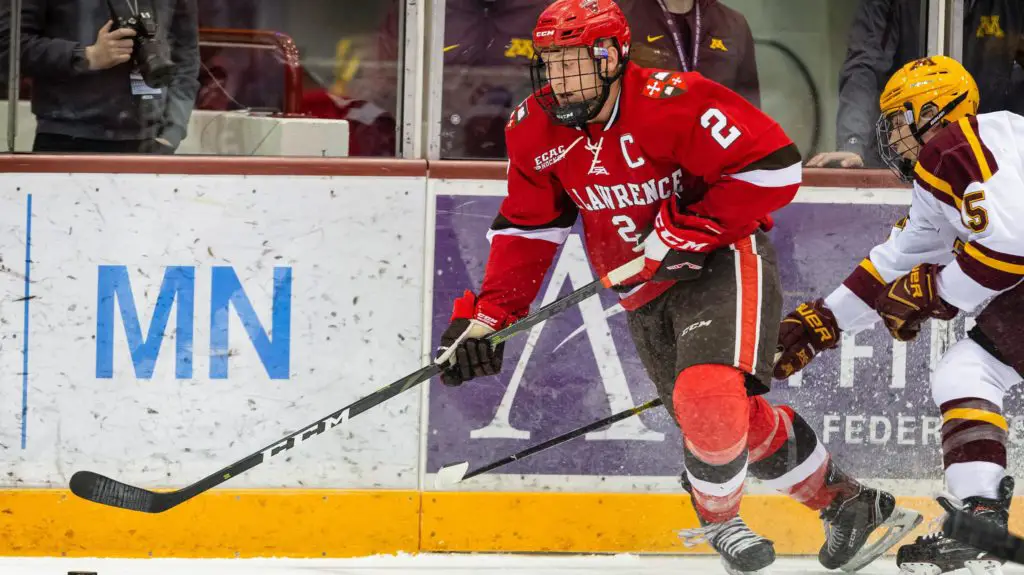
ST. LAWRENCE
Head coach: Brent Brekke, entering his second season at St. Lawrence.
2019-20 overall record: 4-27-5 (2-18-2, last in ECAC Hockey)
Key returning players: Forwards Jordan Steinmetz (5-8-13) and David Jankowski (4-7-11), and defenseman Dylan Woolf (0-7-7)
Key losses: Forwards Zach Risteau (7-16-23) and Keenan Suthers (9-5-14), and defenseman Bo Hanson (5-14-19)
Key additions: Forwards Reilly Moran (Powell River/BCHL), Logan Ritchie (Kenai River/NAHL), and Max Dorrington (Cushing Academy Prep), and defensemen Tucker McIntosh (Ottawa/CCHL) and Luc Salem (Topeka/NAHL)
2020-21 prediction: It can only get better for St. Lawrence, as the Saints had the lowest full season win total in program history last year. St. Lawrence went more than three months between wins last season and then saw its top three scorers transfer in the offseason. The Saints have nine incoming freshman that should push for playing time. The influx of newcomers might lead to some inconsistencies this season, but it also should give the freshmen a chance to gain some valuable experience. The Saints will also have the benefit of playing a full season in Appleton Arena. St. Lawrence didn’t play in its home rink until January 31 last season due to delays in renovations to the arena.


